#British passenger liner
Video


The First Full-Size 3D Scan of The Titanic
The mysterious 1912 sinking of the luxury passenger liner, the Titanic, has long served as a source of fascination for many.
Historians now believe that a new underwater scanning project may provide answers to some of the unanswered questions regarding the tragedy that killed more than 1,500 people.
A team of scientists have used deep sea mapping to create “an exact ‘Digital Twin’ of the Titanic wreck for the first time,” according to a press release Wednesday from deep sea investigators Magellan and filmmakers Atlantic Productions.
By carrying out the “largest underwater scanning project in history,” scientists have managed to “reveal details of the tragedy and uncover fascinating information about what really happened to the crew and passengers on that fateful night” of April 14, 1912, the press release said.
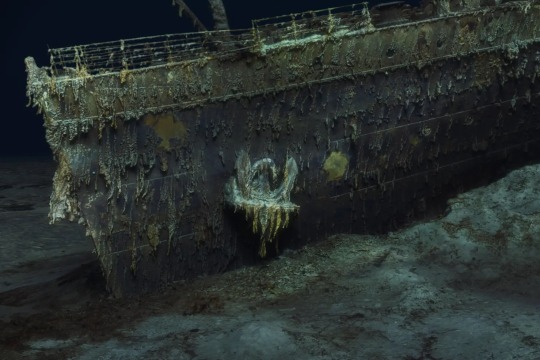

Scans of the wreck were carried out in the summer of 2022 by a specialist ship stationed 700 km (435 miles) off the coast of Canada, according to the release. Tight protocols prohibited team members from touching or disturbing the wreck which investigators stressed was treated with the “utmost of respect.”
Every millimeter of its three-mile debris field was mapped in minute detail, the press statement said. The final digital replica has succeeded in capturing the entire wreck including both the bow and stern section, which had separated upon sinking in 1912.
One such example can be found on the propeller where the serial number can be seen for the first time in decades.


Roughly 715,000 images and 16 terabytes of data were gathered during the expedition – which Magellan estimates to be “approximately ten times larger than any underwater 3D model that’s ever been attempted before,” Magellan CEO Richard Parkinson said.
Parkinson described the mission as “challenging,” referencing the team’s fight against “the elements, bad weather, and technical challenges.”
Whereas previous optical images of the ship were limited by low light level and the poor light quality 12,500 feet below water, the new mapping technique has “effectively taken away the water and let in the light,” the press release said.
According to 3D capture specialist Gerhard Seiffert, the “highly accurate photorealistic 3D model” has enabled people to zoom out and look at the entire wreck “for the first time.”
“This is the Titanic as no one had ever seen it before,” Seiffert added.
By Niamh Kennedy.
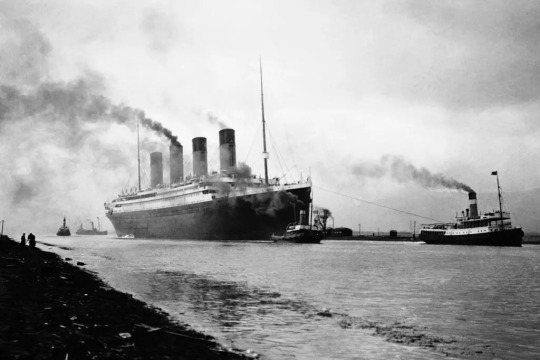
#Titanic#The First Full-Size 3D Scan of The Titanic#British passenger liner#White Star Line#Atlantic Productions
247 notes
·
View notes
Text

HMHS Britannic being maneuvered by tugboats.
Painting by Harley Crossley, 1987.
National Museums of Northern Ireland: M11983
#HMHS Britannic#Britannic#Olympic Class#Hospital Ship#Ocean Liner#Liner#Royal Navy#White Star Line#White Star#Passenger Ship#Ship#World War I#World War 1#WWII#WW1#WWI History#History#Military History#British Royal Navy#November#1916#tugboat#artwork#my post
24 notes
·
View notes
Text

P&O Passenger Services
P&O Round the World Tours
~ Anonymous, circa 1910
19 notes
·
View notes
Text

Fancy a trip? Then welcome to door no. 19, where you can set sail on the SS Great Britain

SS Great Britain
Her history here:
When Brunel’s ocean liner, was built in the nineteenth century the SS GREAT BRITAIN was a bold attempt by a British company to break the American monopoly of the trans-Atlantic passenger trade. Launched by Prince Albert on 19 July 1843, she was the largest and most technically innovative ship of her day, because she was the first iron hulled, screw propelled ship. Her first voyage to America began on 26 July 1845, and she covered 3,100 miles in 14 days and 21 hours.
On the return journey, because of the loss of propeller blades, she used sail only, but still completed the voyage to Liverpool in 20 days. In 1846, however, on her fifth voyage, she ran aground in Dundrum Bay, County Down. It was not until August of the following year that she was refloated and towed back to Liverpool, and, in 1850, was sold to Gibbs, Bright & Co. for service to Australia. She was significantly altered at this time.
In 1854, she was refitted as a troopship for the Crimean War and again in 1857 she carried reinforcements to Bombay to deal with the Indian Mutiny. Returning to the Australian run, she carried the first touring English cricket side. In 1876, she was put up for sale at Birkenhead, but not bought until 1882. Her new owners, Anthony Gibbs, Sons & Co. converted her entirely to a sailing vessel for transporting coal to San Francisco and returning with wheat. After two such voyages, in 1886, she was dismasted by a hurricane off Cape Horn and she put into the Falkland Islands. As repairs were considered too expensive, she became a hulk for storing coal and wool. On April 14 1937, she was towed a few miles out of Port Stanley to shallow water in Sparrow Cove; holes were punched in her bottom and she settled on the seabed. The organisation required to co-ordinate the task of recovery came into being in 1968, led by Dr Ewan Corlett. In April 1970, she was refloated, returning to her original dock Bristol in July that year where she underwent a major conservation programme.
In 2006, an appeal was launched to help restore the masts of the SS GREAT BRITAIN. Two of the masts and part of a third needed to be urgently replaced as they had become badly degraded. The vessel was successful in winning the prestigious Gulbenkian Prize as UK Museum of the Year 2006, which brought with it £100,000 in prize money. This was put towards the costs of the masts. The ship also won two awards at the Museums and Heritage Awards for Excellence 2006 conference in the restoration and conservation category as well as permanent exhibition. The project was also awarded the Civic Trust Award 2006 for accessibility. These Awards follow the relaunch of GREAT BRITAIN after work costing £11.3 million to transform her into a major visitor attraction and museum, as well as to preserve the vessel for future generations. The ship saw more than 160,000 visitors between July 2005 and September 2006.
#naval history#naval artifacts#ss great britain#ocean liner#brunel#1843#age of sail#advent calendar#day 19
99 notes
·
View notes
Text
I got curious about how 19th century newspapers actually reported on storms and shipwrecks. Here's an example from the Teesdale Mercury, 29th January 1890:
RESCUED IN MID-OCEAN
The liner Gallia brings particulars of the rescue of 18 mariners in the North Atlantic by Captain Munro, of the British steamship Stag, on the 29th ult [?], while on a voyage from Shields to New York. The sinking ship was the old American clipper-built ship Shakespeare, and the crew had already been left to their fate by one passenger steamer, and had abandoned all hope. Captain Munro in his account says the wind was blowing at hurricane force, and his ship was making its way through big seas when the wreck was seen through a veil of hail and rain. He made for the vessel, and found it was a dismasted ship, wit h the crew waving and shouting in a frenzy of despair. He continues: " At that time it was blowing a frightful hurricane, and a boat could not have lived a moment in the seas. Shortly after a heavy snow squall shut out the fast-sinking ship, and all that day and night the vessel was obscured, but every once in a while we could see the flash of lights and rockets telling us where they were. All that night we sailed about the ship, hoping that the storm would abate sufficiently to allow us to go to the crew's succour. For hours we could not see their distress signals, and it gave me intense anxiety for fear I would lose them. When morning dawned I again made a search for the ship. After hours of fruitless endeavour the snow squall suddenly ceased, the mist cleared away, and disclosed the ship to our view. She was almost level wit h the water. The sea was still frightfully high, but I knew that the crew's safety depended upon m y promptness. I ordered away the port quarter boat and called for volunteers to man it . Every one of my crew to a man instantly responded. Second-officer Noell and four of my
ablest seamen manned the first boat and rowed to the rescue. On account of the heavy sea the boat could not get within 50ft. of the sinking ship. Then those on the ship threw my men a line. I shouted to everyone to put a lifebelt on and jump into the sea, and then, with the aid of the rope, pull themselves through. Owing to the sea my lifeboat could only rescue five men the first time, and it made four successive trips, each of the men having first to jump into the sea, and then, with the aid of the line which was attached to the ship, swim towards the lifeboat. On the two last trips a fresh crew of volunteers, in charge of First-officer William Hanson, went to the wreck. Chief-officer Fred Matte, the last person to leave the sinking vessel, could not hold on to the rope, his hands being so sore and blistered from exposure and cold, and had to swim the whole distance, my men dragging him out of the water benumbed and exhausted. The rescue, although attended with the gravest difficulty, was successfully accomplished, and the conduct of my men and the presence of mind displayed by the Shakespeare's crew are deserving of the highest praise. We abandoned the ship and the late captain's pet dog to the mercy of the elements, and continued on our trip . The rescued men were weak and exhausted from fatigue and exposure, and were one mass of bruises and sores. They had been tossing about the Atlantic for nearly three months, having left Hamburg on Oct. 24. Their ship was dismasted in a gale on Dec. 17, in which she also sprang a leak. For four days and nights, amid frightful hurricanes, the big seas constantly sweeping over them, the brave crew manfully worked at the pumps in a hopeless endeavour to keep their ship afloat. Capt. Mullar died from heart disease on Dec. 16, and just as a big sea swept his ship on the following day, hurling the mizenmast wit h part of the mainmast to the deck, his body was buried in the sea."
Who knew that one of the areas where Bram Stoker allowed himself creative licence was the inclusion of paragraph breaks?
89 notes
·
View notes
Text

April 14, 1912 -- The British passenger liner RMS Titanic hits an iceberg in the North Atlantic at 23:40 (sinks morning of April 15th).
16 notes
·
View notes
Text
Boat trains
Boat trains were dedicated railway services that operated from London and some other places to British ports to connect with ships. These trains did not go on the ships themselves, bar the Night Ferry, which is much later than the period we're discussing.
You could buy through tickets from London to various continental destinations (as well as places like the Channel Islands or Ireland) and these dedicated trains were indeed generally limited solely to those heading overseas. Liverpool Street, Charing Cross and Victoria were particularly associated with them:
Liverpool Street used Platforms 9 and 10 for its trains and you could actually walk into the Great Eastern Hotel directly from the platform.
Victoria used Platforms 1, 2 and 8. 2 is still commonly used for charter services and the British Pullman that connects with the Venice Simplon Orient Express, although the latter connection is stopping from 2024, partly due to Brexit.
Blackfriars had a wall showing the various destinations "served" from there, which is still on display after being cleaned up.
Once across the Channel/North Sea, you would board another connecting train operated by the relevant local company. London to Paris was therefore doable within a day. These through connections included the Orient Express, which had carriages from Calais and the various European destinations were displayed on the departure boards:

Trains also operated in connection with the ocean liners that left from places like Southampton.
As Watson does in "The Final Problem", you could register your heavier luggage subject to fees if you went over a certain weight and have this carried in a separate luggage section, it being moved between trains, ships etc. by porters. I am sure some of it got lost.
British Railways even developed a special battery-powered railcar, the Class 419 Motor Luggage Van, for the purpose of carrying registered luggage onto the quays at Dover where a third rail would cause safety issues, which would be attached to the main train until detached there.
Immigration formalities would be dealt with at the ports, but you could sometimes also deal with customs at your destination for registered luggage, Victoria having a facility for this.
Boat trains were considered the most premium expresses, using the most modern carriages, the newest engines, and the most experienced crews. They would also provide at-seat catering in some cases for first class passengers. Bradshaw's has plenty of advertisements for them.
Boat trains to Dover continued to run until the opening of the Channel Tunnel in 1994. You can still get through tickets from London to the Netherlands via the Harwich-Hoek van Holland ferry, but there is no longer a dedicated train, which stopped in 2007.
50 notes
·
View notes
Text
The RMS Titanic
(This post is LONG sorry not sorry, also it's 2.20am as I am about to press post, that's a little creepy that I finished this post at almost the same time the Titanic slipped under the waves on the 15th, I know it's the 14th now but still little creepy)
(Also if I got anything wrong feel free to tell me, as it is hard to find which info is true)
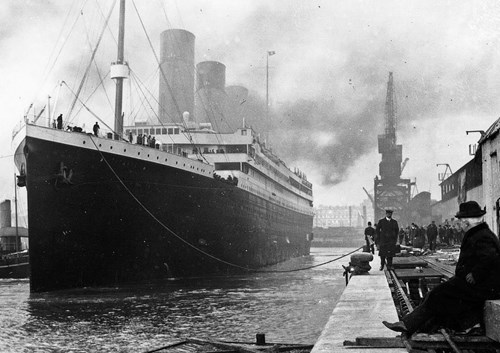
112 years since The RMS Titanic sank in the early morning of April 15 1912 after stacking an Iceberg late at night on April 14 taking more than 1,517 lives with her, into the North Atlantic Ocean.
The RMS (Royal Mail Ship) Titanic was a British passenger and Mail Carrying ocean liner owned by White Star Line she cost $7.5 million to make in 1912 in today's money that would be around $244,994,210 in 2014 (if I worked it out right).
She was one of the largest Ships on the seas next to her sister The RMS Olympic and The HMHS Britannic,
Construction of the Titanic started in March 1909 only a couple of months after the Construction had started on Olympic December 1908, The Britannic would not start Construction until 1911. Her builder where Harland & Wolff shipyard in Belfast.
The Titanic stood 175 ft from her keel to the top of her Funnels, with the length of around 882 ft and a width of 92 ft, weighing in at sound 52,310 tons, her installed power was 24 double-ended and five single-ended boilers feeding two reciprocating steam engines for the wing propellers, and a low-pressure turbine for the centre propeller with an output of 46,000 horsepower.
She had 9 decks from from A to G (I would go into say what all the Deck are but this would make the post into a novel)
She had 2 Two three-blade wing propellers standing at 23 ft and 38 tons and one centre propeller standing at 16 ft and 17 tons.
Her service speed was 12 kn 24 MPH her max was 23kn 26 MPH,
She had the capacity of around 2,453 passengers and around 874 crew.
Was designed to carry 64 lifeboats but that was halved to 32 and on her maiden voyage she only had 20 lifeboats when she left.
The Titanic was laid down (start building) on March 31 1909, she was then launched (being transferred from a dry dock to water) on 31 May 1911, Completed on 2 April 1912 and had her Maiden Voyage on the 10 of April 1912.
She did have to sail from Belfast Where she was built on April 2 1912 to Southampton but that was not classed as her Maiden voyage.
On her maiden Voyage her passengers numbered approximately 1,317 people: 324 in First Class, 284 in Second Class, and 709 in Third Class. Of these, 869 (66%) were male and 447 (34%) female. There were 107 children aboard, the largest number of whom were in Third Class. With around 900 crew members,
The estimated duration of the journey was approximately going to be 5 to 7 from Southampton to New York, porting at Cherbourg in France and Queenstown (Now known as Cobh) in Southern Ireland in between where some Titanic passengers would disembark and some would board. ( https://titanicfacts.net/titanic-maiden-voyage/ can have a look at this site, It give you a little break down of her journey I did not wanna put it all in this post, it’s already long)
Her first days at sail went by without a hitch until the night of April 14 when at 11:40pm she hit an Iceberg on her starboard side (right side) of her hull below the waterline slicing open the hull between five of the adjacent watertight compartments. If only one or two of the compartments had been opened, Titanic might have stayed afloat, but when so many were sliced open, the watertight integrity of the entire forward section of the hull was fatally breached. Titanic slipped below the waves at 2:20am on 15 April.
The timeline that I found says that she hit the Iceberg at 11.40pm 14th, at 12.40am on the 15th Captain Smith gave the order to uncover the lifeboats and to evacuate women and children at 12.45am the first lifeboat is launch with only 28 people on when it could hold up to 65.
It took the Titanic around 2 hours and 40 minutes to sink taking with her around 1,517 lives,
(This may not be the right numbers but it what we know or what we think to be know as I have seen many different number of who sadly passed and who did not)
Men -
First class Total on Board 175 - Lots 118 - Survived 57
Second Class Total on Board 168 - Lots 154 - Survived 14
Third class Total on Board 456 - Lots 381 - Survived 75
Crew Total on Board 863 - Lots 674 - Survived 189
Woman -
First class Total on Board 143 - Lots 4 - Survived 139
Second Class Total on Board 94 - Lots 15 - Survived 79
Third class Total on Board 165 - Lots 89 - Survived 76
Crew Total on Board 21 - Lots 3 - Survived 18
Children -
First class Total on Board 6 - Lots 1 - Survived 5
Second Class Total on Board 23 - Lots 0 - Survived 23
Third class Total on Board 79 - Lots 53 - Survived 26
April 15 1912 would be the last day anyone saw the Titanic above the waves,
The next time anyone would set eyes on the Titanic again would be 73 years later on the 1st of September 1985 sitting 13,000 feet under the sea in two halves, as she split in half in the skinking (https://www.titanicbelfast.com/history-of-titanic/titanic-stories/finding-titanic-from-search-to-seabed/#:~:text=Although%20the%20Titanic%20lies%20in,the%20world's%20most%20famous%20ship! A site talking about the events on finding the Titanic)
Now in 2024 she has laid there for 112 years, but sadly in the next coming years some say maybe 2030 the Titanic with collapse completely as a rust-eating bacterium found on the ship named Halomonas Titanicae, which has been found to cause rapid decay of the wreck.
It will be sad to see her fully lost to us but she will always be remembered.
Not to sound cheesy but as the song once said “My heart will go on” Titanic's heart will go on and the hearts of all the lost people.
(this may make the post EVEN more long but, a heart for every 1,517 soul that was lots may they rest in peace)
💙💙💙💙💙💙💙💙💙💙💙💙💙💙💙💙💙💙💙💙💙💙💙💙💙💙💙💙💙💙💙💙💙💙💙💙💙💙💙💙💙💙💙💙💙💙💙💙💙💙💙💙💙💙💙💙💙💙💙💙💙💙💙💙💙💙💙💙💙💙💙💙💙💙💙💙💙💙💙💙💙💙💙💙💙💙💙💙💙💙💙💙💙💙💙💙💙💙💙💙💙💙���💙💙💙💙💙💙💙💙💙💙💙💙💙💙💙💙💙💙💙💙💙💙💙💙💙💙💙💙💙💙💙💙💙💙💙💙💙💙💙💙💙💙💙💙💙💙💙💙💙💙💙💙💙💙💙💙💙💙💙💙💙💙💙💙💙💙💙💙💙💙💙💙💙💙💙💙💙💙💙💙💙💙💙💙💙💙💙💙💙💙💙💙💙💙💙💙💙💙💙💙💙💙💙💙💙💙💙💙💙💙💙💙💙💙💙💙💙💙💙💙💙💙💙💙💙💙💙💙💙💙💙💙💙💙💙💙💙💙💙💙💙💙💙💙💙💙💙💙💙💙💙💙💙💙💙💙💙💙💙💙💙💙💙💙💙💙💙💙💙💙💙💙💙💙💙💙💙💙💙💙💙💙💙💙💙💙💙💙💙💙💙💙💙💙💙💙💙💙💙💙💙💙💙💙💙💙💙💙💙💙💙💙💙💙💙💙💙💙💙💙💙💙💙💙💙💙💙💙💙💙💙💙💙💙💙💙💙💙💙💙💙💙💙💙💙💙💙💙💙💙💙💙💙💙💙💙💙💙💙💙💙💙💙💙💙💙💙💙💙💙💙💙💙💙💙💙💙💙💙💙💙💙💙💙💙💙💙💙💙💙💙💙💙💙💙💙💙💙💙💙💙💙💙💙💙💙💙💙💙💙💙💙💙💙💙💙💙💙💙💙💙💙💙💙💙💙💙💙💙💙💙💙💙💙💙💙💙💙💙💙💙💙💙💙💙💙💙💙💙💙💙💙💙💙💙💙💙💙💙💙💙💙💙💙💙💙💙💙💙💙💙💙💙💙💙💙💙💙💙💙💙💙💙💙💙💙💙💙💙💙💙💙💙💙💙💙💙💙💙💙💙💙💙💙💙💙💙💙💙💙💙💙💙💙💙💙💙💙💙💙💙💙💙💙💙💙💙💙💙💙💙💙💙💙💙💙💙💙💙💙💙💙💙💙💙💙💙💙💙💙💙💙💙💙💙💙💙💙💙💙💙💙💙💙💙💙💙💙💙💙💙💙💙💙💙💙💙💙💙💙💙💙💙💙💙💙💙💙💙💙💙💙💙💙💙💙💙💙💙💙💙💙💙💙💙💙💙💙💙💙💙💙💙💙💙💙💙💙💙💙💙💙💙💙💙💙💙💙💙💙💙💙💙💙💙💙💙💙💙💙💙💙💙💙💙💙💙💙💙💙💙💙💙💙💙💙💙💙💙💙💙💙💙💙💙💙💙💙💙💙💙💙💙💙💙💙💙💙💙💙💙💙💙💙💙💙💙💙💙💙💙💙💙💙💙💙💙💙💙💙💙💙💙💙💙💙💙💙💙💙💙💙💙💙💙💙💙💙💙💙💙💙💙💙💙💙💙💙💙💙💙💙💙💙💙💙💙💙💙💙💙💙💙💙💙💙💙💙💙💙💙💙💙💙💙💙💙💙💙💙💙💙💙💙💙💙💙💙💙💙💙💙💙💙💙💙💙💙💙💙💙💙💙💙💙💙💙💙💙💙💙💙💙💙💙💙💙💙💙💙💙💙💙💙💙💙💙💙💙💙💙💙💙💙💙💙💙💙💙💙💙💙💙💙💙💙💙💙💙💙💙💙💙💙💙💙💙💙💙💙💙💙💙💙💙💙💙💙💙💙💙💙💙💙💙💙💙💙💙💙💙💙💙💙💙💙💙💙💙💙💙💙💙💙💙💙💙💙💙💙💙💙💙💙💙💙💙💙💙💙💙💙💙💙💙💙💙💙💙💙💙💙💙💙💙💙💙💙💙💙💙💙💙💙💙💙💙💙💙💙💙💙💙💙💙💙💙💙💙💙💙💙💙💙💙💙💙💙💙💙💙💙💙💙💙💙💙💙💙💙💙💙💙💙💙💙💙💙💙💙💙💙💙💙💙💙💙💙💙💙💙💙💙💙💙💙💙💙💙💙💙💙💙💙💙💙💙💙💙💙💙💙💙💙💙💙💙💙💙💙💙💙💙💙💙💙💙💙💙💙💙💙💙💙💙💙💙💙💙💙💙💙💙💙💙💙💙💙💙💙💙💙💙💙💙💙💙💙💙💙💙💙💙💙💙💙💙💙💙💙💙💙💙💙💙💙💙💙💙💙💙💙💙💙💙💙💙💙💙💙💙💙💙💙💙💙💙💙💙💙💙💙💙💙💙💙💙💙💙💙💙💙💙💙💙💙💙💙💙💙💙💙💙💙💙💙💙💙💙💙💙💙💙💙💙💙💙💙💙💙💙💙💙💙💙💙💙💙💙💙💙💙💙💙💙💙💙💙💙💙💙💙💙💙💙💙💙💙💙💙💙💙💙💙💙💙💙💙💙💙💙💙💙💙💙💙💙💙💙💙💙💙💙💙💙💙💙💙💙💙💙💙💙💙💙💙💙💙💙💙💙💙💙💙💙💙💙💙💙💙💙💙💙💙💙💙💙💙💙💙💙💙💙💙💙💙💙💙💙💙💙💙💙💙💙💙💙💙💙💙💙💙💙💙💙💙💙💙💙💙💙💙💙💙💙💙💙💙💙💙💙💙💙💙💙💙💙💙💙💙💙💙💙💙💙💙💙💙💙💙💙💙💙💙💙💙💙💙💙💙💙💙💙💙💙💙💙💙💙💙💙💙💙💙💙💙💙💙💙💙💙💙💙💙💙💙💙💙💙💙💙💙💙💙💙💙💙💙💙💙💙💙💙💙💙💙💙💙💙💙💙💙💙💙💙💙💙💙💙💙💙💙💙💙💙💙💙💙💙💙💙💙💙💙💙💙💙💙💙💙💙💙💙💙💙💙💙💙💙💙💙💙💙💙💙💙💙💙💙💙💙💙💙💙💙💙💙💙💙💙💙💙💙💙💙💙💙💙💙💙💙💙💙💙💙💙💙💙💙💙💙💙💙💙💙💙💙💙💙💙💙💙💙💙💙💙💙💙💙💙💙💙💙💙💙💙💙💙💙💙💙💙💙💙💙💙💙💙💙💙💙💙💙💙💙💙💙💙💙💙💙💙💙💙💙💙💙💙💙💙💙💙💙💙💙💙💙💙💙💙💙💙💙💙💙💙💙💙💙💙💙💙💙💙💙💙💙💙💙💙💙💙💙💙💙💙💙💙💙💙💙💙💙💙
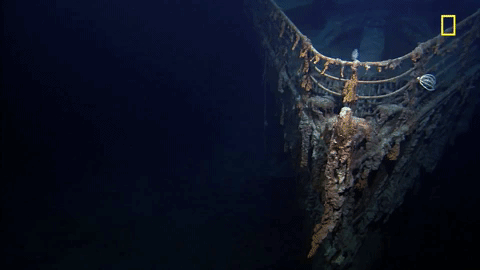
#The RMS Titanic#Titanic#May the people that lost thire lives rest in peace#I was going to say something about the Sub but I thought that did not really fit as this was about when the Titanic sank not the Sub time#Not that their lives do not matter they do may they also rest in peace
5 notes
·
View notes
Text
Today's problematic ship is the St. Louis

We recevied an ask recently about this ship, but Tumblr is being an ass and is not allowing me to answer it – but since the St. Louis really deserves to be featured, here it goes.
The St. Louis was a combined liner/cruise ship built for HAPAG (Hamburg-America Line) in 1928. It became infamous in 1939, when the ship left Hamburg for Cuba carrying over 900 passengers, most of them Jewish refugees fleeing Nazi persecution.
While the St. Louis was en route to Havana, Cuban legislation was altered to disallow all foreign nationals except US Americans from entering the county, rendering the previously-legal entrace visas of the St. Louis' passengers worthless. In the end, only 28 passengers were allowed to disembark in Havana.
After being denied entry to Cuba, the ship set sail for the USA, but the refugees were also denied entry there. After Canada similarly refused entry, the St. Louis was forced to sail back to Europe. As conditions onboard the ship worsened, captain Gustav Schröder considered running the ship aground on the British coast, thus forcing Britain to accept the refugees (an unsubstantiated story also claims he attempted the same manoevre earlier on the coast of Florida, only to be stopped by the US coast guard), but in the end Schröder was able to negotiate a solution where Britain, France, Belgium and the Netherlands took all the passengers onboard, with the St. Louis arriving at Antwerp on 17 June to discharge passengers, after which it sailed empty to Hamburg.
As Belgium, France and the Netherlands were all occupied by Nazi Germany during World War II, it is estimated that 27 percent of the St. Louis' passengers were murdered during the Holocaust.
(And since this was a subject of the ask: the St. Louis was used as an accommodation ship from 1940 onwards until scrapped in 1952).
85 notes
·
View notes
Video

A Gold and Megalodon Shark Tooth Necklace Found at Titanic Wreck
A lost necklace made from the tooth of a megalodon shark has been found in the iconic wreckage of the RMS Titanic.
The necklace hasn't been seen since the infamous sinking of the luxury passenger liner—considered to be the most advanced of its time—111 years ago.
The Titanic sank after colliding with an iceberg in the North Atlantic, about 370 miles southeast of Halifax, Nova Scotia on April 15, 1912. The ship was four days into her maiden voyage from Southampton, England, to New York City.
The disaster resulted in the deaths of over 1,500 people—more than two-thirds of the crew and passengers who were onboard at the time.
The story of the tragedy holds a special place in the popular imagination, having been the subject of exhibitions, documentaries and Hollywood blockbusters—including James Cameron's 1997 Academy Award-winning drama.
The necklace was found by Magellan, a company based in Guernsey, a self-governing British Crown dependency located in the English Channel, near the coast of France. The firm specializes in underwater site investigations and seabed mapping.
As part of an underwater scanning project, Magellan snapped 700,000 images of the Titanic wreck using two submarines. Using these images, the company then created the first-ever full-sized digital scan of the Titanic, providing a remarkable new view of the wreck.
Among the images captured, the Magellan team managed to spot the megalodon tooth necklace, which also contains gold.
The find was "astonishing, beautiful and breathtaking," Magellan CEO Richard Parkinson said in a statement.
Megalodon is huge shark that is thought to have become extinct around 3.6 million years ago. Considered the largest shark to have ever lived, the earliest known megalodon remains date back more than 20 million years.
Magellan didn't extract the megalodon tooth necklace from the wreck due to an agreement between U.S. and U.K. authorities that prevents such removals by members of the public.
By Aristos Georgiou.


#Titanic#A Gold and Megalodon Shark Tooth Necklace Found at Titanic Wreck#British passenger liner#White Star Line#jewelry#necklace#history#history news
57 notes
·
View notes
Text
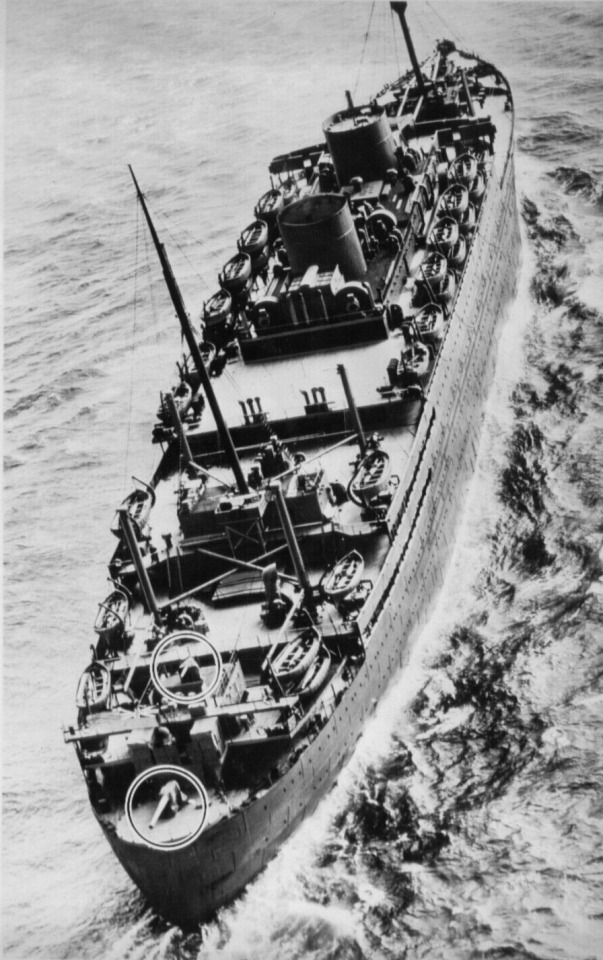
"MV Georgic puts out to sea, ready to fight! Armed with deck guns (circled) and read to fight either planes or submarines, the British liner Georgic slipped out of New York Harbor today to try it's luck at running the German U-Boats or plane blockade. Neither her destination, nor the number of passengers she carried was disclosed."
Released on October 28, 1939
AP Wired photo: C7 L610DNS 39
#MV Georgic#Georgic#Ocean Liner#Liner#Motor Vessel#Cunard-White Star Line#White Star Line#White Star#Royal Navy#October#1939#world war ii#world war 2#WWII#WW2#History#my post
16 notes
·
View notes
Text
Trans-Atlantic Heart Trade intro!!
It is a romance webcomic set in the 1930s and focuses on the budding relationship between the wireless operators of the R.M.S Queen Mary and the S.S Normandie as their boats become the greatest maritime rivals in existence
Why the name?
Trans-Atlantic Heart Trade (TAHT) for short is a play on words for the Trans-Atlantic Passenger Trade, a booming industry that relied on ocean liners for years until passenger planes became the method of travel,
When will it be posted?
August 31st 09:30 GMT!
What's this account gonna be used for?
General brain rotting, progress updated and a place to throw my characters into the void and as an archive of sorts for all that's made for this project incase of a technology fail
Who are the main characters?
James Peterson is a British male from Leeds who is 27, 6'0ft and pansexual, his birthday is the 6th February and he works on the R.M.S Queen Mary
Georges Gillian Alleman is a French male from the Normandy area who is 26, 5'9ft and gay a homosexual if you will, his birthday is the 18th September and he works on the S.S Normandie
Why boats?
They're cool and I think there should be more maritime romances that aren't Titanic flavoured
15 notes
·
View notes
Text

Steve Brodner
* * * *
LETTERS FROM AN AMERICAN
April 15, 2024
HEATHER COX RICHARDSON
APR 16, 2024
April 15 is a curiously fraught day in American history.
In 1861, President Abraham Lincoln called for 75,000 volunteers to put down a rebellion in the southern states.
In 1865, Lincoln breathed his last at 7:22 a.m., and Secretary of War Edwin Stanton, who adored the president, said, “Now he belongs to the ages.”
In 1912 the British passenger liner RMS Titanic sank at 2:20 a.m. after hitting an iceberg in the North Atlantic.
In 1920, two security guards in Braintree, Massachusetts, were murdered on this date; Nicola Sacco and Bartolomeo Vanzetti would be accused of the crime, convicted, and, in 1927, executed.
In 1947, Jackie Robinson debuted for the Brooklyn Dodgers, breaking the color line in baseball’s major leagues.
In 2013, two bombs exploded near the finish line of the Boston Marathon, killing three people and wounding 264 others.
And on April 15, 2024, the criminal case of The People of New York v. Donald J. Trump began in Manhattan.
For the first time in history, a former president is facing criminal prosecution.
The case has been dubbed a “hush money” case by the media, but it is really a case about election interference. In 2016, shortly after the Access Hollywood tape in which then-candidate Trump boasted of sexually assaulting women became public, Trump allegedly falsified business records of the Trump Organization to hide payments to individuals who possessed damaging stories about him, especially about his behavior with women, before the election.
Then–Trump fixer Michael Cohen paid adult film actress Stormy Daniels, who alleged she had had an affair with Trump, $130,000 through a shell company. He also set up a $150,000 payment from the publisher of the National Enquirer to Playboy model Karen McDougal, who also claimed to have had an affair with Trump. That money would give the National Enquirer exclusive rights to the story, meaning they could decline to publish it and she could not take it elsewhere. This practice is known as “catch-and-kill.”
Trump then allegedly falsified business records to reimburse Cohen for “legal expenses.” Manhattan district attorney Alvin Bragg has charged Trump with 34 counts of falsifying those records. The case might last as long as 8 weeks.
In many ways, this trial is a vindication of the rule of law. Despite his many attempts to delay it, a former president is facing accountability for his actions just as any American should.
The trial schedule reflected that standard practice. Presiding judge Juan Merchan set out the terms of the trial, covering what information the jury can hear about Trump and reminding Trump that, per the laws of New York, if he fails to appear in court as required, a warrant will be issued for his arrest.
But as jury selection began today, it was also clear that this is no normal trial. The names of the jurors will not be released outside the courtroom out of concerns for their safety, underscoring the degree to which Trump has urged his supporters to violence. And the country is so deeply divided over Trump and his movement that more than half of the first batch of jurors were excused when they said they could not judge the case impartially. No jurors were chosen today.
Trump has used this case—like his others—to try to undermine the rule of law. Rarely arguing that he didn’t commit any of the offenses for which he was charged in four different cases—two civil, two criminal—he has insisted instead that he is being unfairly prosecuted. The Democrats have rigged the judicial system against him, he repeatedly claims, and enough of his loyalists have bought that idea that today some of them urged Trump supporters in the jury pool to undermine the rule of law by lying to get on the jury, then refusing to convict (a plea that observers noted sounded like jury tampering).
Trump’s effort to signal that he remains disgusted by the charges against him continued today. New York Times reporter Maggie Haberman noted that “[s]hortly before court adjourned for the day, Trump’s campaign sent out a fundraising email falsely claiming he had just stormed out of court.” But it was notable that only a few dozen of his supporters showed up at the court today, and they did not stay long.
Trump has also refused to stop attacking the judge and other participants in the trial despite a gag order imposed by the judge. Today, even as prosecutors were asking Judge Merchan to find Trump in contempt for violating the gag order, Trump posted a video in which one of his allies attacked the judge’s wife as well as primary witness Michael Cohen.
Judge Merchan has scheduled a hearing on potential violations of the gag order for the morning of April 23.
Trump is trying to undermine the rule of law not only out of apparent fear of the outcome of his trials, but also because his appearance in court is likely to hurt his popularity. Last month an Ipsos poll showed that 32% of respondents said a conviction in this case would make them less likely to support Trump for the presidency. And that is before we have heard any of the new evidence that various sources have said we will hear, and which, by the nature of the case, is likely to be sordid.
Seeing Trump treated like any defendant is almost certain to damage his brand as a man who commands his surroundings. Today, Haberman noted: “One thing that is striking: Trump has used the previous court appearances in other cases to project an image of grandeur. That is hard to do in this dingy courtroom, which smells slightly off and where he is an island amid a sea of people.”
Further, the public nature of this trial will make it harder for Trump to present himself only through carefully curated appearances. Haberman also noted that Trump, who has repeatedly attacked President Joe Biden as “Sleepy Joe,” appeared to fall asleep during today’s proceedings. “Repeatedly, his head would fall down,” Haberman said. “He didn’t pay attention to a note his lawyer…passed him. His jaw kept falling on his chest and his mouth kept going slack.” (While Trump was nodding off in court, President Biden was meeting in the Oval Office with Prime Minister Mohammed Shyaa al-Sudani of the Republic of Iraq, and then with Prime Minister Petr Fiala of the Czech Republic.)
Outside of this case, Trump’s image as a wealthy man is also crumbling. Today was the day by which Trump’s lawyers needed to prove that the $175 million appeals bond he posted against the $454 million judgment in the fraud case would really secure the judgment. Late tonight, his lawyers filed their justification of the bond, insisting it was secure and saying there was no need for the hearing about it, scheduled for April 22. Legal analysts on social media immediately found errors in the document.
Trump’s lawyers also filed paperwork today with the Securities and Exchange Commission to issue more than 20 million more shares of common stock in the Trump Media & Technology Group. The price of the company’s stock has been dropping since the spike after the initial public offering of March 26. Upon today’s news it dropped another 18%. It has dropped 62% since public trading began.
Although news from Manhattan took up most of the oxygen today, the Commerce Department also made a major announcement: through the CHIPS and Science Act it is investing up to $6.4 billion in a Samsung Electronics chip manufacturing and research cluster in Taylor, Texas. Commerce Secretary Gina Raimondo said the two proposed factories will create at least 17,000 construction and 4,500 manufacturing jobs.
In addition to its historical significance, April 15 is also Tax Day. Biden reinstated the tradition of voluntarily releasing tax returns after Trump ended it, and today Biden, First Lady Jill Biden, Vice President Kamala Harris, and Second Gentleman Douglas Emhoff all released their taxes, revealing that their salaries make up most of their income.
Ken Thomas and Ashlea Ebeling of the Wall Street Journal reported that the Trump campaign did not answer questions about whether Trump would release his tax returns.
LETTERS FROM AN AMERICAN
HEATHER COX RICHARDSON
#Letters From An American#Heather Cox Richardson#tax returns#legal jeopardy#Trump Trial#steve brodner#TFG#Tax Day
3 notes
·
View notes
Text
A Canadian military surveillance aircraft detected underwater noises as a massive operation searched early Wednesday in a remote part of the North Atlantic for a submersible that vanished while taking five people down to the wreck of the Titanic.
A statement from the U.S. Coast Guard did not elaborate on what rescuers believed the noises could be, though it offered a glimmer of hope for those lost aboard the Titan. The vessel is estimated to have as little as a day's worth of oxygen left if it is still functioning.
Three search vessels arrived on-scene Wednesday morning, including one that has side-scanning sonar capabilities, the Coast Guard tweeted.
The Coast Guard wrote on Twitter that a Canadian military surveillance aircraft had “detected underwater noises in the search area" and that an underwater robot sent to search that area has so far “yielded negative results.”
Still, authorities pushed on Wednesday to get salvage equipment to the scene in case the sub is found.
The Coast Guard statement about detecting sounds underwater came after Rolling Stone reported that search teams heard “banging sounds in the area every 30 minutes.”
The report was encouraging to some experts because submarine crews unable to communicate with the surface are taught to bang on their submersible’s hull to be detected by sonar.
“It sends a message that you’re probably using military techniques to find me and this is how I’m saying it," said Frank Owen, a submarine search and rescue expert. "So, that’s really encouraging if that’s the case.”
Richard Garriott de Cayeux, the president of The Explorers Club, wrote an open letter to his club’s adventurers, saying he had “much greater confidence” about the search after speaking to officials in Congress, the U.S. military and the White House.
However, no official has publicly suggested they know the source of the underwater noises.
Meanwhile, questions remain about how teams could reach the lost submersible, which could be as deep as about 12,500 feet (3,800 meters) below the surface near the watery tomb of the historic ocean liner. Newly uncovered allegations also suggest there had been significant warnings made about vessel safety during its development.
Lost aboard the vessel are pilot Stockton Rush, the CEO of the company leading the expedition. His passengers are a British adventurer, two members of a Pakistani business family and a Titanic expert.
Three transport planes from the U.S. military have been used to move commercial submersible and support equipment from Buffalo, New York, to St. John’s, Newfoundland, to aid in the search, a spokesperson for U.S. Air Mobility Command said.
The Canadian military said it provided a patrol aircraft and two surface ships, including one that specializes in dive medicine. It also dropped sonar buoys to listen for any sounds from the Titan.
Authorities reported the 22-foot carbon-fiber vessel overdue Sunday night, setting off the search in waters about 435 miles (700 kilometers) south of St. John’s.
The submersible had a four-day oxygen supply when it put to sea around 6 a.m. Sunday, according to David Concannon, an adviser to OceanGate Expeditions, which oversaw the mission.
Owen said the estimated 96-hour oxygen supply is a useful “target” for searchers, but is only based on a “nominal amount of consumption the average human might consume in doing certain things.” Owen said the diver on board the Titan would likely be advising passengers to “do anything to reduce your metabolic levels so that you can actually extend this 96 hours.”
Chris Brown, a British adventurer who paid a deposit to go on the Titan voyage but later withdrew because of what he called safety concerns, said word that the searchers have heard sounds is both good news and bad news.
“If the sounds are coming from below the water indicator then that indicates that they may be alive in the water, but now we’ve got time pressures in getting them up to the surface,” Brown told ABC’s “Good Morning America” Wednesday.
The submersible had seven backup systems to return to the surface, including sandbags and lead pipes that drop off and an inflatable balloon.
Aaron Newman, who has been a passenger on the Titan, told NBC’s “Today” show Wednesday that if the submersible is below a couple hundred meters and without power, the passengers are in complete darkness and it's cold.
“It was cold when we were at the bottom,” he said. “You had layered up. You had wool hats on and were doing everything to stay warm at the bottom.”
Meanwhile, documents show that OceanGate had been warned there might be catastrophic safety problems posed by the way the experimental vessel was developed.
David Lochridge, OceanGate’s director of marine operations, said in a 2018 lawsuit that the company’s testing and certification was insufficient and would “subject passengers to potential extreme danger in an experimental submersible.”
The company insisted that Lochridge was “not an engineer and was not hired or asked to perform engineering services on the Titan.” The firm also says the vessel under development was a prototype, not the now-missing Titan.
The Marine Technology Society, which describes itself as “a professional group of ocean engineers, technologists, policy-makers, and educators,” also expressed concern that year in a letter to Rush, OceanGate’s chief executive. The society said it was critical that the company submit its prototype to tests overseen by an expert third party before launching in order to safeguard passengers. The New York Times first reported about those documents.
The search for the missing vessel has drawn international attention. In Dubai, where the missing British adventurer Hamish Harding lives, Crown Prince Hamadan bin Mohammed Al Maktoum wrote: “Dubai and its people pray for their safety and hopeful return home.”
Others aboard include Pakistani nationals Shahzada Dawood and his son Suleman, whose eponymous firm invests across the country. In Pakistan's port city of Karachi, employees at his firms said they prayed for the two's safe return, as did government officials. French explorer and Titanic expert Paul-Henry Nargeolet also was on the vessel.
Describing Harding and Nargeloet as “tourists” is a misnomer, said Newman, the former Titan passenger.
“These are people who lived on the edge and loved what they were doing. If anything’s going on, these are people that are calm and thinking this through and doing what they can to stay alive,” Newman said, adding that he felt safe and in the hands of professionals on his descent. “It’s a good set of people.”
13 notes
·
View notes
Note
do you believe any of the conspiracies about the titanic?
whats your favorite titanic fact?
yeah, im very boring and i do not believe a single conspiracy theory about the titanic. theres not a single one ive heard that hasnt been debunked resolutely:
switch theory
coal fire theory
anything to do with titanic using substandard materials
i also dont really know if i have a favourite fact about it because its not really one of my favourite ocean liners (that honour goes to ms stockholm, the ss malolo, the rms empress of ireland and ss united states)
i will say that i enjoy the fact that the switch theory is all about an insurance scam, but they only insured a third of the ship, so it was a very bad insurance scam if it was one
if i had to come up with a favourite fact, i guess id for for one thats pretty well-known about how only the first three funnels were actually connected to the furnaces where they burnt the coal for fuel. the fourth acted as a chimney flute for the first class smoking room and also provided air ventilation to the galleys iirc.
i moreso like the fact because of why titanic had four funnels. see titanic came at a time where germany, france, britain and italy were all vying for domination on the north atlantic route and the lines were constantly outdoing each other with technological innovation and passenger spaces. this began with white star lines ss atlantic which sailed her maiden voyage in 1871 and to begin with, it was mostly british lines fighting to outdo each other until 1897 when ss kaiser wilhelm der grosse steamed onto the scene massively outdoing everyone.
and kaiser wilhelm had four funnels and so that became a trend. your ship would be seen as inferior if it didnt have four funnels, and that trend continues for decades really. pretty much up into ww2, honestly.
and so thats why titanic was designed with four funnels despite only needing four. it was basically a signal that your ship was top of the line and safe to sail on.
#anon#titanic#thank you for the ask anon <333#but i am wondering if im now becoming known as like the titanic guy#which like i guess i kinda am because i just know a lot about most ocean liners including titanic#i very much do enjoy these asks#i just get to be really autistic and infodump#shipposting
9 notes
·
View notes
Photo
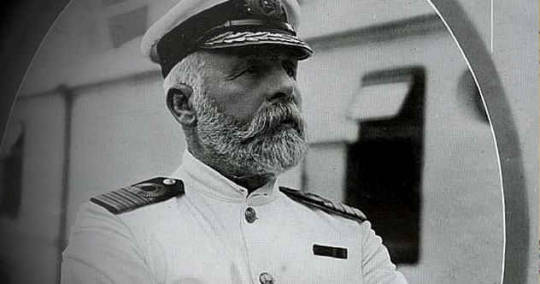
Titanic Premonition
There have been many articles pointing out the seemingly eerie prediction of the fate of the Titanic in the form of novels which mirror many details of the ship and its journey. But perhaps not many people realize that the captain of the liner, Edward J Smith himself, also seemed to have a premonition that all would not go well on the maiden voyage across the Atlantic.
In a collection of his letters, which were sold in 2016, he laments the fact he was no longer taking command of the Cymric, another ship, and instead placed as captain of the Titanic. More ominous is a letter to his sister written just two days before the liner hit the iceberg in which he writes, “I still don’t like this ship. . . I have a queer feeling about it.”
Captain Smith was a highly experienced seaman who had recently been on the Titanic’s sister ship, the Olympic, when she was involved in a collision, yet he had nothing but fond feelings for that particular vessel. Why then, did he feel so uneasy about a ship he had only just set foot on?
Whatever the reason, fascination has continued to surround the doomed captain ever since. Many tales have sprung up around him, including the story of Second Officer Leonard Bishop of the SS Winterhaven, who, in 1977, was conducting a tour of his ship to one of his passengers. This passenger was a quiet, attentive man with a British accent. At the time, Bishop felt there was something strange about the man but could not say exactly what it was. A few years later he came across a picture of a captain of a ship and exclaimed, “I know that man; I gave him a tour of my ship.” The man in the photograph was Captain Edward J Smith.
29 notes
·
View notes